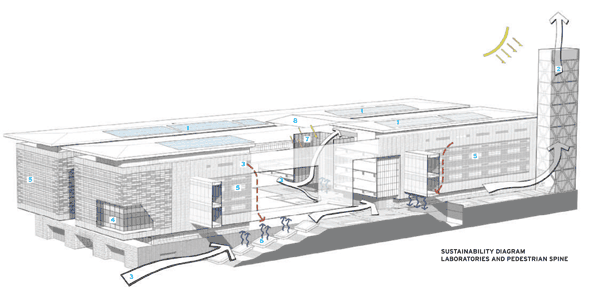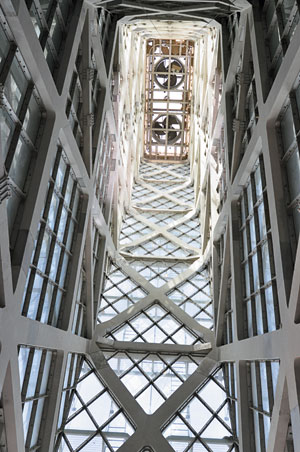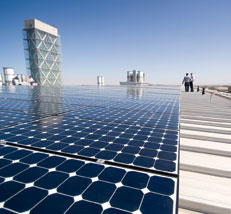KAUST
To ensure that future rising sea levels and changing climate patterns do not adversely affect the campus - designed as a 100-year building - work crews elevated the site by adding 8 feet of soil, creating a massive plinth. The plinth includes the lower stone walls of the campus buildings as well as the stone horizontal surfaces that make up the plaza and courtyard hardscapes. Between the plinth and the shading roof, which in some areas spans up to 195 feet, the restrained, earth-toned building faces reside. These terra-cotta enclosures are distinguished from the stone plinth by a window ribbon of glass. Integral solar shading over most of the facades reduces heat loads and creates dappled light in building interiors.

|
||||
 |
||||
Â
 |
Two 195-foot-tall solar towers act like chimneys to ventilate the courtyard spaces between lab buildings. A high-strength, precast-concrete diagrid frame supports two layers of glass. The sun heats the air within the tower to draw it upward. Fans at the top provide supplemental airflow. Photo: © JB Picoulet |
The roof is articulated as a monumental floating plane hovering above all the buildings. Much of its upper surface's 900,000 square feet is covered in an array of large solar-photovoltaic and solar-thermal panels. While the combination of these two systems provides just 7.8 percent of the total energy required to operate the campus, as the faculty and student population increases - the 2009 inaugural academic year consisted of 72 faculty and 374 students, but those numbers are expected to reach 600 and 2,000, respectively - future plans call for the creation of a solar farm to harness much more of the sun's potential. Because the sun is so intense on the site, how the campus addresses the sun's energy is a key part of KAUST's sustainable strategy.
The design team employed primarily passive solutions, including building placement and orientation, shading, and daylighting, to achieve much of the campuswide energy reduction. "Sustainable design is passive first," says Duncan Phillips of RWDI. "If we have to introduce a system to solve something, it's because we haven't solved it passively."
At KAUST, many of the sustainable strategies are invisible, but two very prominent sustainable features are the 195-foot-tall solar towers, which have become campus icons. (The only other nearby vertical element is the campus mosque's smaller minaret.) The glazed towers serve an important, mostly passive, role in terms of comfort by ventilating the courtyard spaces between the lab clusters. More important, from a safety perspective, since some of the labs are expected to be wet labs where chemicals and biological materials are tested, designers had to ensure that the particles that come out of those labs do not go back into the buildings. The towers act as chimneys in which the sun and wind work together to draw the tainted air out. Dampers located near the top of the towers regulate airflow and prevent downdraft in negative pressure conditions. Fans provide supplemental airflow under extreme demands. The labs also utilize a heat-recovery ventilation system to provide fresh air while saving energy.










